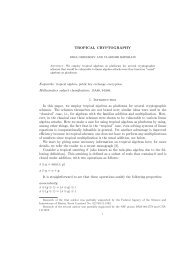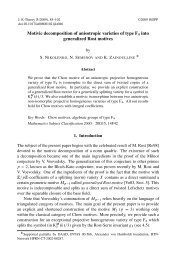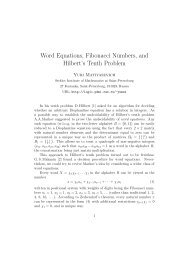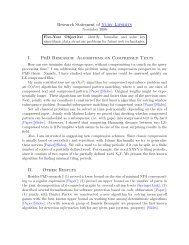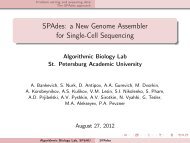SPAdes - Theodosius Dobzhansky Center for Genome Bioinformatics
SPAdes - Theodosius Dobzhansky Center for Genome Bioinformatics
SPAdes - Theodosius Dobzhansky Center for Genome Bioinformatics
- No tags were found...
You also want an ePaper? Increase the reach of your titles
YUMPU automatically turns print PDFs into web optimized ePapers that Google loves.
Problem setting and preparing dataThe <strong>SPAdes</strong> approach<strong>SPAdes</strong>: a New <strong>Genome</strong> Assembler <strong>for</strong> Single-CellSequencingAlgorithmic Biology LabSt. Petersburg Academic UniversityA. Bankevich, S. Nurk, D. Antipov, A.A. Gurevich, M. Dvorkin,A.S. Kulikov, V.M. Lesin, S.I. Nikolenko, S. Pham, A.D. Prjibelski,A.V. Pyshkin, A.V. Sirotkin, N. Vyahhi, G. Tesler, M.A. Alekseyev,P.A. PevznerApril 28, 2012Algorithmic Biology Lab, SPbAU<strong>SPAdes</strong>
OutlineProblem setting and preparing dataThe <strong>SPAdes</strong> approachAssembly: problem and pipelineError correction: BayesHammer1 Problem setting and preparing dataAssembly: problem and pipelineError correction: BayesHammer2 The <strong>SPAdes</strong> approachDe Bruijn graphs, mate-pairs, and simplificationPaired de Bruijn graphs and repeatsAlgorithmic Biology Lab, SPbAU<strong>SPAdes</strong>
Problem setting and preparing dataThe <strong>SPAdes</strong> approachThe assembly problemAssembly: problem and pipelineError correction: BayesHammerIn many sequencing methods, we read ≈ L nucleotides fromboth ends of a longer DNA fragment.This leads to paired-end reads (read pairs): two reads <strong>for</strong>which we know the distance between them (Chaisson et al.,2009).left readgenomeright readread lengthgapdistanceinsert sizeread lengthAlgorithmic Biology Lab, SPbAU<strong>SPAdes</strong>
MDA technologyProblem setting and preparing dataThe <strong>SPAdes</strong> approachAssembly: problem and pipelineError correction: BayesHammerRecent single-cell sequencing projects use the MDA technology(Chitsaz et al., 2011; Rodrigue et al., 2009)Algorithmic Biology Lab, SPbAU<strong>SPAdes</strong>
MDA technologyProblem setting and preparing dataThe <strong>SPAdes</strong> approachAssembly: problem and pipelineError correction: BayesHammerComputational problems of MDA:1 highly non-uni<strong>for</strong>m coverage;2 more chimeric connections (sometimes with large coverage);3 more frequent errors.Algorithmic Biology Lab, SPbAU<strong>SPAdes</strong>
Assembly pipelineProblem setting and preparing dataThe <strong>SPAdes</strong> approachAssembly: problem and pipelineError correction: BayesHammerAlgorithmic Biology Lab, SPbAU<strong>SPAdes</strong>
BayesHammerProblem setting and preparing dataThe <strong>SPAdes</strong> approachAssembly: problem and pipelineError correction: BayesHammerBasic idea: break reads into k-mers and study the set ofk-mers.ACGTGTGATGCATGATCGACGTGTGATGCCGTGTGATGCAGTGTGATGCATTGTGATGCATGGTGATGCATGATGATGCATGATGATGCATGATCATGCATGATCGk-mers are the basic building block in modern assemblers (deBruijn graph). However, de Bruijn graphs are not directlyapplicable because of errors in reads.Algorithmic Biology Lab, SPbAU<strong>SPAdes</strong>
BayesHammerProblem setting and preparing dataThe <strong>SPAdes</strong> approachAssembly: problem and pipelineError correction: BayesHammerThe first step in assembly is to fix as many errors as we can.If we know what k-mers are correct, it’s easy to correct reads.solid k-mersoriginal readACGTGTGATGCATGATCGACGTGTGATGCcorrectionCGTGTGATGCAGTGTGATGCATTGTGATGCATGGTGATGCATGATGATGCATGATGATGCATGATCATGCATGATCGcorrectioncorrectionACGTGTGATGCATGATCGACGTGTGATGCCGTGAGATGCAGTGAGATGCATTGTGATGCATGGTGATGCATGAAGATGCATGATGATGCATGATCATGCATGATCGACGTGAGATGCATGATCGcorrected readAlgorithmic Biology Lab, SPbAU<strong>SPAdes</strong>
BayesHammerProblem setting and preparing dataThe <strong>SPAdes</strong> approachAssembly: problem and pipelineError correction: BayesHammerIn regular (multi-cell) error correction, we can look at howmany copies of a k-mer there are and assume that rare k-mersrepresent errors.In single-cell datasets, this idea fails due to non-uni<strong>for</strong>mcoverage.<strong>SPAdes</strong> (and BayesHammer) introduces many novel ideas tohandle the non-uni<strong>for</strong>m case.10 4 KBases10 210 00 1,000 2,000 3,000 4,000Algorithmic Biology Lab, SPbAU<strong>SPAdes</strong>
BayesHammerProblem setting and preparing dataThe <strong>SPAdes</strong> approachAssembly: problem and pipelineError correction: BayesHammerBasic idea: a k-mer is covered many times (even ifnon-uni<strong>for</strong>mly).Thus, if we look at the set of similar k-mers we can find outwhat to do because nucleotides of the central k-mer will bebetter covered than others.Problem: there may be several centers in such a cluster.ATGTGTGATGCACGTGGGATGCACGTGTGATGCACGTGTGATGCATGTGTGATGCACGTGAGATGCACGTGTGATGCATGTGGGATGCACGTGGGATGCACGTGGGATGCACGTGTGATGCATGTGTGATGCACGTGTGATACACGTGTGATGCACGTGGGATGCAlgorithmic Biology Lab, SPbAU<strong>SPAdes</strong>
BayesHammerProblem setting and preparing dataThe <strong>SPAdes</strong> approachAssembly: problem and pipelineError correction: BayesHammerIn Hammer, Medvedev et al. (2011) constructed and roughlyclustered the Hamming graph of k-mers; BayesHammer usesprobabilistic subclustering to get multiple centers in a cluster.ReadsACGTGTGACATGTGACCTGTCk-mersACGTGCGTGTGTGTGACATGCATGTATGTGACCTGCCTGTCTGTCHamming graphACATGACCTGACGTG CGTGTCATGTATGTG CCTGTGTGTG CTGTCAs a result, BayesHammer corrects single-cell datasets muchbetter than other tools.Algorithmic Biology Lab, SPbAU<strong>SPAdes</strong>
OutlineProblem setting and preparing dataThe <strong>SPAdes</strong> approachDe Bruijn graphs, mate-pairs, and simplificationPaired de Bruijn graphs and repeats1 Problem setting and preparing dataAssembly: problem and pipelineError correction: BayesHammer2 The <strong>SPAdes</strong> approachDe Bruijn graphs, mate-pairs, and simplificationPaired de Bruijn graphs and repeatsAlgorithmic Biology Lab, SPbAU<strong>SPAdes</strong>
De Bruijn graphsProblem setting and preparing dataThe <strong>SPAdes</strong> approachDe Bruijn graphs, mate-pairs, and simplificationPaired de Bruijn graphs and repeatsWhen there are relatively few k-mers left, we can begin globalprocessing (the actual assembly).Basic idea: de Bruijn graph (Idury & Waterman, 1995;Pevzner et al., 2001).Algorithmic Biology Lab, SPbAU<strong>SPAdes</strong>
De Bruijn graphsProblem setting and preparing dataThe <strong>SPAdes</strong> approachDe Bruijn graphs, mate-pairs, and simplificationPaired de Bruijn graphs and repeatsAlgorithmic Biology Lab, SPbAU<strong>SPAdes</strong>
De Bruijn graphsProblem setting and preparing dataThe <strong>SPAdes</strong> approachDe Bruijn graphs, mate-pairs, and simplificationPaired de Bruijn graphs and repeatsAlgorithmic Biology Lab, SPbAU<strong>SPAdes</strong>
De Bruijn graphsProblem setting and preparing dataThe <strong>SPAdes</strong> approachDe Bruijn graphs, mate-pairs, and simplificationPaired de Bruijn graphs and repeatsAlgorithmic Biology Lab, SPbAU<strong>SPAdes</strong>
De Bruijn graphsProblem setting and preparing dataThe <strong>SPAdes</strong> approachDe Bruijn graphs, mate-pairs, and simplificationPaired de Bruijn graphs and repeatsAlgorithmic Biology Lab, SPbAU<strong>SPAdes</strong>
De Bruijn graphsProblem setting and preparing dataThe <strong>SPAdes</strong> approachDe Bruijn graphs, mate-pairs, and simplificationPaired de Bruijn graphs and repeatsAlgorithmic Biology Lab, SPbAU<strong>SPAdes</strong>
Problem setting and preparing dataThe <strong>SPAdes</strong> approachDe Bruijn graph and errorsDe Bruijn graphs, mate-pairs, and simplificationPaired de Bruijn graphs and repeatsNow, if there is a single string uniting all k-mers, itcorresponds to a Eulerian cycle/path in this graph.However, due to sequencing errors and repeats we cannot justfind a Eulerian cycle/path and think that we’re done.In the presence of errors, this is a hard problem, and not verywell defined.Algorithmic Biology Lab, SPbAU<strong>SPAdes</strong>
Problem setting and preparing dataThe <strong>SPAdes</strong> approachDe Bruijn graph be<strong>for</strong>e simplificationDe Bruijn graphs, mate-pairs, and simplificationPaired de Bruijn graphs and repeatsAlgorithmic Biology Lab, SPbAU<strong>SPAdes</strong>
Problem setting and preparing dataThe <strong>SPAdes</strong> approachDe Bruijn graph simplification: tipsDe Bruijn graphs, mate-pairs, and simplificationPaired de Bruijn graphs and repeatsThere are three kinds of common errors in the de Bruijn graph.They all have additional complications in the single-cell case.A tip results from a single error close to the end of a read.<strong>SPAdes</strong> incorporates a tip clipping algorithm that is enhancedby gap closing (see below).Algorithmic Biology Lab, SPbAU<strong>SPAdes</strong>
Problem setting and preparing dataThe <strong>SPAdes</strong> approachDe Bruijn graph simplification: bulgesDe Bruijn graphs, mate-pairs, and simplificationPaired de Bruijn graphs and repeatsThere are three kinds of common errors in the de Bruijn graph.They all have additional complications in the single-cell case.A bulge occurs when the error is in the middle.<strong>SPAdes</strong> projects bulges with additional bookkeeping topreserve the original mappings – bulge corremoval.Algorithmic Biology Lab, SPbAU<strong>SPAdes</strong>
Problem setting and preparing dataThe <strong>SPAdes</strong> approachDe Bruijn graph simplification: chimerasDe Bruijn graphs, mate-pairs, and simplificationPaired de Bruijn graphs and repeatsThere are three kinds of common errors in the de Bruijn graph.They all have additional complications in the single-cell case.A chimeric connection joins two unrelated parts of the graph.<strong>SPAdes</strong> uses a novel algorithm <strong>for</strong> removing chimericconnections based on max-flow graph algorithms.Algorithmic Biology Lab, SPbAU<strong>SPAdes</strong>
Problem setting and preparing dataThe <strong>SPAdes</strong> approachDe Bruijn graph simplification: schedulingDe Bruijn graphs, mate-pairs, and simplificationPaired de Bruijn graphs and repeatsThere are three kinds of common errors in the de Bruijn graph.They all have additional complications in the single-cell case.And they are all usually superimposed in a single entangledmess.<strong>SPAdes</strong> uses special scheduling algorithms to process bulgesand chimerics in an optimal order.Algorithmic Biology Lab, SPbAU<strong>SPAdes</strong>
Problem setting and preparing dataThe <strong>SPAdes</strong> approachDe Bruijn graph simplificationDe Bruijn graphs, mate-pairs, and simplificationPaired de Bruijn graphs and repeatsTo sum up: <strong>for</strong> single-cell datasets, errors are harder to correctbecause coverage is not a reliable way to recognize an error.We have developed several new algorithms that process errorsbased on graph structure rather than coverage alone.Besides, <strong>SPAdes</strong> corrects errors iteratively, in an order resultingfrom special scheduling policies.Algorithmic Biology Lab, SPbAU<strong>SPAdes</strong>
Problem setting and preparing dataThe <strong>SPAdes</strong> approachMultisized de Bruijn graphsDe Bruijn graphs, mate-pairs, and simplificationPaired de Bruijn graphs and repeatsLet us now think about the value of k. How does the graphchange if k changes?For a small k, the graph is well-connected but very entangled.Algorithmic Biology Lab, SPbAU<strong>SPAdes</strong>
Problem setting and preparing dataThe <strong>SPAdes</strong> approachMultisized de Bruijn graphsDe Bruijn graphs, mate-pairs, and simplificationPaired de Bruijn graphs and repeatsLet us now think about the value of k. How does the graphchange if k changes?For a large k, the graph is less entangled but may becomedisconnected.Algorithmic Biology Lab, SPbAU<strong>SPAdes</strong>
Problem setting and preparing dataThe <strong>SPAdes</strong> approachMultisized de Bruijn graphsDe Bruijn graphs, mate-pairs, and simplificationPaired de Bruijn graphs and repeatsLet us now think about the value of k. How does the graphchange if k changes?<strong>SPAdes</strong> combines several different values of k to get the bestof all worlds (see also IDBA (Peng et al., 2010)).Algorithmic Biology Lab, SPbAU<strong>SPAdes</strong>
RepeatsProblem setting and preparing dataThe <strong>SPAdes</strong> approachDe Bruijn graphs, mate-pairs, and simplificationPaired de Bruijn graphs and repeatsA repeat in the genome results in a path with multipleentrances and/or multiple exits. Sometimes they can beresolved with long reads; sometimes not, and they becometangles.This repeat is easy to handle.Algorithmic Biology Lab, SPbAU<strong>SPAdes</strong>
RepeatsProblem setting and preparing dataThe <strong>SPAdes</strong> approachDe Bruijn graphs, mate-pairs, and simplificationPaired de Bruijn graphs and repeatsA repeat in the genome results in a path with multipleentrances and/or multiple exits. Sometimes they can beresolved with long reads; sometimes not, and they becometangles.This one is not.Algorithmic Biology Lab, SPbAU<strong>SPAdes</strong>
Problem setting and preparing dataThe <strong>SPAdes</strong> approachPaired reads and paired de Bruijn graphsDe Bruijn graphs, mate-pairs, and simplificationPaired de Bruijn graphs and repeatsRecall that reads come in pairs.We could construct a paired de Bruijn graph in which verticescorrespond to pairs of k-mers (Medvedev et al., 2011). Thisgraph is much sparser than a regular de Bruijn graph.Algorithmic Biology Lab, SPbAU<strong>SPAdes</strong>
Problem setting and preparing dataThe <strong>SPAdes</strong> approachPaired reads and paired de Bruijn graphsDe Bruijn graphs, mate-pairs, and simplificationPaired de Bruijn graphs and repeatsAlgorithmic Biology Lab, SPbAU<strong>SPAdes</strong>
Problem setting and preparing dataThe <strong>SPAdes</strong> approachPaired reads and paired de Bruijn graphsDe Bruijn graphs, mate-pairs, and simplificationPaired de Bruijn graphs and repeatsAlgorithmic Biology Lab, SPbAU<strong>SPAdes</strong>
Problem setting and preparing dataThe <strong>SPAdes</strong> approachPaired reads and paired de Bruijn graphsDe Bruijn graphs, mate-pairs, and simplificationPaired de Bruijn graphs and repeatsAlgorithmic Biology Lab, SPbAU<strong>SPAdes</strong>
Problem setting and preparing dataThe <strong>SPAdes</strong> approachPaired reads and paired de Bruijn graphsDe Bruijn graphs, mate-pairs, and simplificationPaired de Bruijn graphs and repeatsAlgorithmic Biology Lab, SPbAU<strong>SPAdes</strong>
Problem setting and preparing dataThe <strong>SPAdes</strong> approachPaired DBG in <strong>SPAdes</strong>De Bruijn graphs, mate-pairs, and simplificationPaired de Bruijn graphs and repeatsRepeat resolution in <strong>SPAdes</strong> stems from the basic idea of apaired de Bruijn graph (with a few extra strategies).In theory, there’s no difference between theory and practice; inpractice, there is: the distance between paired reads is notknown exactly.This is a major problem <strong>for</strong> implementing paired de Bruijngraphs.Algorithmic Biology Lab, SPbAU<strong>SPAdes</strong>
Problem setting and preparing dataThe <strong>SPAdes</strong> approachPaired DBG in <strong>SPAdes</strong>De Bruijn graphs, mate-pairs, and simplificationPaired de Bruijn graphs and repeats<strong>SPAdes</strong> approach to distance estimation: choose distances(from a finite set given by graph structure) by clusteringexisting paired info.Algorithmic Biology Lab, SPbAU<strong>SPAdes</strong>
Closing gapsProblem setting and preparing dataThe <strong>SPAdes</strong> approachDe Bruijn graphs, mate-pairs, and simplificationPaired de Bruijn graphs and repeatsGaps in coverage lead to discontinuities in the de Bruijn graph.Sometimes, gaps can be closed if matching paired info isavailable.gap closingwith readsACGTGTGATGCATGATCG...TCGATCGACGTGTGATGCTGCATGATCGAATGTAT...gap closing ...TCGATCGACGTGTGATGCwith read pairs TGCATGATCGAATGTAT...CGTGTG ATCGAAACGTGT GATCGAGACGTG TGATCG<strong>SPAdes</strong> closes gaps not only during scaffolding, but also be<strong>for</strong>etip clipping.Algorithmic Biology Lab, SPbAU<strong>SPAdes</strong>
Problem setting and preparing dataThe <strong>SPAdes</strong> approachDe Bruijn graph be<strong>for</strong>e simplificationDe Bruijn graphs, mate-pairs, and simplificationPaired de Bruijn graphs and repeatsAlgorithmic Biology Lab, SPbAU<strong>SPAdes</strong>
Problem setting and preparing dataThe <strong>SPAdes</strong> approachDe Bruijn graph after simplificationDe Bruijn graphs, mate-pairs, and simplificationPaired de Bruijn graphs and repeatsAlgorithmic Biology Lab, SPbAU<strong>SPAdes</strong>
OmnigraphProblem setting and preparing dataThe <strong>SPAdes</strong> approachDe Bruijn graphs, mate-pairs, and simplificationPaired de Bruijn graphs and repeatsNote that many of these procedures (graph simplification,repeat resolution) actually do not depend on the underlyingsequence, but only on a few edge parameters (coverage,length, paired info).In the code, these operations are abstracted out and made intogeneral graph algorithms; we call this approach the omnigraph.Compare with A-Bruijn graph (Pevzner, Tang, Tesler, 2004).Algorithmic Biology Lab, SPbAU<strong>SPAdes</strong>
OmnigraphProblem setting and preparing dataThe <strong>SPAdes</strong> approachDe Bruijn graphs, mate-pairs, and simplificationPaired de Bruijn graphs and repeatsThus, <strong>SPAdes</strong> can be used <strong>for</strong> other similar problems, e.g.proteome assembly (although no real-life projects have beencompleted yet).In general, assemblers often make unjustified assumptions; inthe single-cell case, such assumptions are wrong much moreoften.We have designed SPADES to make more accurate assemblies,cutting less corners than other assemblers; <strong>for</strong> single-cellprojects, it is more important than ever.Algorithmic Biology Lab, SPbAU<strong>SPAdes</strong>
ResultsProblem setting and preparing dataThe <strong>SPAdes</strong> approachDe Bruijn graphs, mate-pairs, and simplificationPaired de Bruijn graphs and repeatsAssembler# contigsN50 (bp)Largest (bp)Total (bp)Covered (%)MisassembliesMismatches(per 100 kbp)Single-cell E. coli (ECOLI-SC)EULER-SR 1344 26662 126616 4369634 87.8 21 11.0 3457SOAPdenovo 1240 18468 87533 4237595 82.5 13 99.5 3059Velvet 428 22648 132865 3533351 75.8 2 1.9 3117Velvet-SC 872 19791 121367 4589603 93.8 2 1.9 3654E+V-SC 501 32051 132865 4570583 93.8 2 6.7 3809<strong>SPAdes</strong>-single reads 1164 42492 166117 4781576 96.1 1 6.2 3888<strong>SPAdes</strong> 1024 49623 177944 4790509 96.1 1 5.2 3911Normal multicell sample of E. coli (ECOLI-MC)EULER-SR 295 110153 221409 4598020 99.5 10 5.2 4232IDBA 191 50818 164392 4566786 99.5 4 1.0 4201SOAPdenovo 192 62512 172567 4529677 97.7 1 26.1 4141Velvet 198 78602 196677 4570131 99.9 4 1.2 4223Velvet-SC 350 52522 166115 4571760 99.9 0 1.3 4165E+V-SC 339 54856 166115 4571406 99.9 0 2.9 4172<strong>SPAdes</strong>-single reads 445 59666 166117 4578486 99.9 0 0.7 4246<strong>SPAdes</strong> 195 86590 222950 4608505 99.9 2 3.7 4268Complete genesAlgorithmic Biology Lab, SPbAU<strong>SPAdes</strong>
All together nowProblem setting and preparing dataThe <strong>SPAdes</strong> approachDe Bruijn graphs, mate-pairs, and simplificationPaired de Bruijn graphs and repeatsAlgorithmic Biology Lab, SPbAU<strong>SPAdes</strong>
All together nowProblem setting and preparing dataThe <strong>SPAdes</strong> approachDe Bruijn graphs, mate-pairs, and simplificationPaired de Bruijn graphs and repeatsAlgorithmic Biology Lab, SPbAU<strong>SPAdes</strong>
All together nowProblem setting and preparing dataThe <strong>SPAdes</strong> approachDe Bruijn graphs, mate-pairs, and simplificationPaired de Bruijn graphs and repeatsAlgorithmic Biology Lab, SPbAU<strong>SPAdes</strong>
CollaborationsProblem setting and preparing dataThe <strong>SPAdes</strong> approachDe Bruijn graphs, mate-pairs, and simplificationPaired de Bruijn graphs and repeatsCollaborations on single-cell projects:1 National Institute of Health (NIH), USA – Human MicrobiomeProject (HMP);2 J. Craig Venter Institite (JCVI);3 Joint <strong>Genome</strong> Institute (JGI) – Genomic Encyclopedia <strong>for</strong>Bacteria and Archaea (GEBA);4 Department of Ecology and Evolutionary Biology, YaleUniversity.Other projects:1 Scripps Institution of Oceanography – colony of bacteria;2 Moscow State University.Algorithmic Biology Lab, SPbAU<strong>SPAdes</strong>
Thank you!Problem setting and preparing dataThe <strong>SPAdes</strong> approachDe Bruijn graphs, mate-pairs, and simplificationPaired de Bruijn graphs and repeatsThank you <strong>for</strong> your attention!Algorithmic Biology LabSt. Petersburg Academic UniversityA. Bankevich, S. Nurk, D. Antipov, A.A. Gurevich, M. Dvorkin, A.S. Kulikov,V.M. Lesin, S.I. Nikolenko, S. Pham, A.D. Prjibelski, A.V. Pyshkin,A.V. Sirotkin, N. Vyahhi, G. Tesler, M.A. Alekseyev, P.A. PevznerAlgorithmic Biology Lab, SPbAU<strong>SPAdes</strong>



